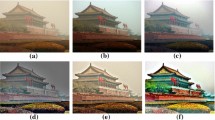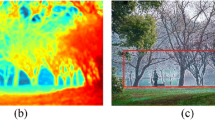Abstract
The natural occurrences of haze, mist and fog obscures the optically captured outdoor scenes. The essential parameters of the atmospheric scattering model for dehazing are air-light (which depends on atmospheric light) and transmission map. Inaccurate estimation of these parameters leads to halo-artifacts, color distortions, etc. The performance of the available single-image dehazing models is limited by the color shifts caused due to the offset of light sources. The proposed work estimates the atmospheric light component by considering the lowest entropy from the quad-decomposed image as the haze opaque regions in the scene considered has low entropy. The transmission map is estimated by computing the scattering parameter, further refined with the holistic edges to calculate haze at different densities. A regression model is trained with the haze relevant features such as hue disparity, contrast, and darkness to compute the scattering coefficient rigorously. This improves the color shifts and visibility of the degraded outdoor scenes and mitigates the imbalances in the haze density concentrations in the scenes. The current model is evaluated using reference-based and non-reference based metrics to emphasize its perceptibility on hazy images when blended with pure light and non-achromatic light. The evaluations on real-hazy images signify that the true colors are well preserved, and the degree of visibility is improved compared to the state-of-the-art models.









Similar content being viewed by others
References
Berman D, Avidan S, et al. (2016) Non-local image dehazing. In: Proceedings of the IEEE conference on computer vision and pattern recognition, pp 1674–1682
Canny J (1986) A computational approach to edge detection. IEEE Transactions on pattern analysis and machine intelligence 6:679–698
Cantor A (1978) Optics of the atmosphere–scattering by molecules and particles. IEEE J Quantum Electron 14(9):698–699
Chen Z, Li X, Zheng H, Gao H, Wang H (2018) Domain adaptation and adaptive information fusion for object detection on foggy days. Sensors 18:3286,09
Chen J, Ying H, Liu X, Gu J, Feng R, Chen T, Gao H, Wu J (2020) A transfer learning based super-resolution microscopy for biopsy slice images: the joint methods perspective. IEEE/ACM transactions on computational biology and bioinformatics 18(1):103–113
Deng G, Cahill L (1993) Multiscale image enhancement using the logarithmic image processing model. Electron Lett 29:803–804,05
Deng G, Cahill L, Tobin G (1995) The study of logarithmic image processing model and its application to image enhancement. IEEE Trans Image Process 4(4):506–512
Fattal R (2008) Single image dehazing. ACM Trans Graph 27:08
Fattal R (2014) Dehazing using color-lines. ACM transactions on graphics (TOG) 34(1):1–14
He K, Sun J, Tang X (2011) Single image haze removal using dark channel prior. IEEE Trans Pattern Anal Mach Intell 33(12):2341–2353
J. Yu, Xiao C, Li D (2010) Physics-based fast single image fog removal. In: IEEE 10th International Conference On Signal Processing Proceedings, pp 1048–1052
Ju M, Ding C, Guo YJ, Zhang D (2020) Idgcp: Image dehazing based on gamma correction prior. IEEE Trans Image Process 29:3104–3118
Kansal I, Singh Kasana S (2020) Improved color attenuation prior based image de-fogging technique. Multimed Tools Appl, 01
Kim T, Paik J, Kang B (1998) Contrast enhancement system using spatially adaptive histogram equalization with temporal filtering. Consumer Electronics IEEE Transactions on 44:82–87, 03
Kopf J, Neubert B, Chen B, Cohen M, Cohen-Or D, Deussen O, Uyttendaele M, Lischinski D (2008) Deep photo: Model-based photograph enhancement and viewing. ACM Trans Graph (TOG) 27:116,12
Lakshmi T. V. (2018) Reduction of features to identify characters from degraded historical manuscripts. Alexandria engineering journal 57(4):2393–2399
Liang D, Kaneko S, Hashimoto M, Iwata K, Zhao X, Satoh Y (2014) Robust object detection in severe imaging conditions using co-occurrence background model. Int J Optomechatronics 8:04
Linan Y, Yan P, Xiaoyuan Y (2012) Video defogging based on adaptive tolerance. TELKOMNIKA Indonesian Journal of Electrical Engineering 10:11
Liu C, Zhao J, Shen Y, Zhou Y, Wang X, Ouyang Y (2016) Texture filtering based physically plausible image dehazing. Vis Comput 32:05
Long J, Shi Z, Tang W (2012) Fast haze removal for a single remote sensing image using dark channel prior. In: 2012 International Conference on Computer Vision in Remote Sensing, pp 132–135
Lv X, Chen W, Shen I (2010) Real-time dehazing for image and video. In: 2010 18th Pacific Conference on Computer Graphics and Applications, pp 62–69
Meng G, Wang Y, Duan J, Xiang S, Pan C (2013) Efficient image dehazing with boundary constraint and contextual regularization. In: 2013 IEEE International Conference on Computer Vision, pp 617–624
Mittal A, Moorthy AK, Bovik AC (2012) No-reference image quality assessment in the spatial domain. IEEE Transactions on image processing 21(12):4695–4708
N D, L G-D, K B (2019) Improved color attenuation prior for single-image haze removal. Appl Sci 9(19):4011
Nafchi HZ, Cheriet M (2018) Efficient no-reference quality assessment and classification model for contrast distorted images. IEEE Trans Broadcast 64(2):518–523
Narasimhan S, Nayar S (2002) Vision and the atmosphere. Int J Comput Vis 48:233–254, 07
Narasimhan SG, Nayar SK (2003) Contrast restoration of weather degraded images. IEEE Trans Pattern Anal Mach Intell 25(6):713–724
O Hulburt E (1941) Optics of atmospheric haze. J Opt Soc Am 31(7):467–476. [Online]. Available: http://www.osapublishing.org/abstract.cfm?URI=josa-31-7-467
Ren W, Liu S, Zhang H, Pan J, Cao X, Yang M-H (2016). In: Leibe B, Matas J, Sebe N, Welling M (eds) Single image dehazing via multi-scale convolutional neural networks, in Computer Vision – ECCV 2016. Springer International Publishing, Cham, pp 154–169
Ren W, Pan J, Zhang H, Cao X, Yang M. -H. (2020) Single image dehazing via multi-scale convolutional neural networks with holistic edges. Int J Comput Vis 128(1):240–259
Schechner YY, Narasimhan S, Nayar S (2001) Instant dehazing of images using polarization. In: Proceedings of the 2001 IEEE computer society conference on computer vision and pattern recognition. CVPR 2001, vol 1. IEEE, pp I–I
Shwartz S, Namer E, Schechner YY (2006) Blind haze separation
Tan R (2008) Visibility in bad weather from a single image 06
Tan Z, Bai X, Wang B, Higashi A (2014) Fast single-image defogging
Tarel J-P, Hautiere N (2009) Fast visibility restoration from a single color or gray level image. In: 2009 IEEE 12th International Conference on Computer Vision. IEEE, pp 2201–2208
Thirumala VL, Karanam VS, Lankireddy PR, Kakumani AK, Yacharam RK (2021) Haze-level prior approach to enhance object visibility under atmospheric degradation. Turk J Elec Eng & Comp Sci 29:2
Vijaya Lakshmi T. R., Sastry P. N., Rajinikanth T. V. (2018) Feature selection to recognize text from palm leaf manuscripts. Signal, Image and Video processing 12(2):223–229
Wang W, Yuan X, Wu X, Liu Y (2017) Fast image dehazing method based on linear transformation. IEEE Transactions on Multimedia 19(6):1142–1155
Xiao C, Gan J (2012) Fast image dehazing using guided joint bilateral filter. Vis Comput 28(6):713–721. [Online]. Available: https://doi.org/10.1007/s00371-012-0679-y
Xiao J, Xu H, Gao H, Bian M, Li Y (2021) A weakly supervised semantic segmentation network by aggregating seed cues: The multi-object proposal generation perspective. ACM Transactions on Multimidia Computing Communications and Applications 17(1s):1–19
Xiao J, Xu H, Zhao W, Cheng C, Gao H (2021) A prior-mask-guided few-shot learning for skin lesion segmentation. Computing, 1–23
Xie S, Tu Z (2015) Holistically-nested edge detection. In: Proceedings of the IEEE international conference on computer vision, pp 1395–1403
Xu H, Guo J, Liu Q, Ye L (2012) Fast image dehazing using improved dark channel prior. In: Proceedings of International Conference on Information Science and Technology, p 03
Yang D, Sun J (2018). In: Ferrari V, Hebert M, Sminchisescu C, Weiss Y (eds) Proximal dehaze-net: A prior learning-based deep network for single image dehazing, in Computer Vision – ECCV 2018. Springer International Publishing, Cham, pp 729–746
Yang H, Wang J, equalization Color image contrast enhancement by co-occurrence histogram, prior dark channel (2010) Proceedings - 2010 3rd International Congress on Image and Signal Processing. CISP 2(10):2010
Zhang Y, Ding Y, Xiao J, Liu J, Guo Z (2012) Visibility enhancement using an image filtering approach. EURASIP Journal on Advances in Signal Processing, vol. 10(2012):1–6
Zhang S, Qing C, Xu X, Jin J, Qin H (2016) Dehazing with improved heterogeneous atmosphere light estimation and a nonlinear color attenuation prior model. In: 2016 10th International Symposium on Communication Systems Networks and Digital Signal Processing (CSNDSP), pp 1–6
Zhu Q, Mai J, Shao L (2015) A fast single image haze removal algorithm using color attenuation prior. IEEE Trans Image Process 24(11):3522–3533
Author information
Authors and Affiliations
Corresponding author
Additional information
Publisher’s note
Springer Nature remains neutral with regard to jurisdictional claims in published maps and institutional affiliations.
Rights and permissions
About this article
Cite this article
Lakshmi, T., Reddy, C.K., Padmavathi, K. et al. Entropy based single image dehazing with refined transmission using holistic edges. Multimed Tools Appl 81, 20229–20253 (2022). https://doi.org/10.1007/s11042-022-12485-z
Received:
Revised:
Accepted:
Published:
Issue Date:
DOI: https://doi.org/10.1007/s11042-022-12485-z




